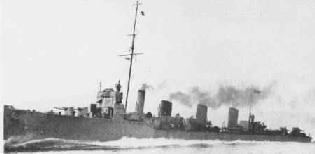HMS Broke (1914)
 |
|
| History | |
|---|---|
|
|
|
| Name: | HMS Broke |
| Builder: | J S White, Cowes |
| Launched: | 25 May 1914 |
| Acquired: | August 1914 |
| Fate: |
|
|
|
|
| Name: | Almirante Uribe |
| Commissioned: | 1920 |
| Decommissioned: | 1933 |
| Fate: | Scrapped in 1933 |
| General characteristics | |
| Class and type: | Faulknor-class destroyer leader |
| Displacement: | 1,700 tons |
| Tons burthen: | 1,850 tons |
| Length: | 331 ft (101 m) o/a |
| Beam: | 32 ft 6 in (9.91 m) |
| Draught: | 11 ft (3.4 m) |
| Propulsion: | 6 White-Forster type water-tube boilers, steam turbines, 3 shafts, 30,000 shp |
| Speed: | 32 knots |
| Range: | 403 tons coal, 83 tons oil |
| Complement: | 197 - 205 |
| Armament: |
|
HMS Broke was a Faulknor-class destroyer leader of the Royal Navy, initially built for the Chilean Navy as the Almirante Lynch-class destroyer Almirante Goñi. The outbreak of the First World War led to her being purchased by the Admiralty in August 1914 shortly after her launching, and renamed HMS Broke. All of the class were present at the Battle of Jutland on 31 May to 1 June 1916 where Broke, out of control after hits from German ships, collided with the Acasta-class destroyer HMS Sparrowhawk leading to the latter's loss. Broke saw action in several battles, and was resold to Chile after the conclusion of the war.
Built as the Almirante Goni by J S White, Cowes, HMS Broke was launched on 25 May 1914, and was completed in 1914.
Broke formed part of the 4th destroyer flotilla commanded by Captain Charles Wintour onboard HMS Tipperary. During the night of 31 May the flotilla was stationed behind (north) of the Grand Fleet to guard against German attack and was heading south keeping station with the fleet. At around 23.15 Leading Torpedoman Cox on board HMS Garland, fourth ship in the twelve strong line, sighted three ships approaching. These were reported to Captain Wintour, who being unable to determine whether the ships were British or German issued a British challenge signal to the approaching ships. This was immediately answered by a hail of fire at a range of around 600 yards from the approaching German light cruisers, SMS Stuttgart, SMS Hamburg, and SMS Elbing. Shortly behind them, the battleships SMS Westfalen and SMS Nassau also opened fire with their secondary armament. The ships were the van of the German High Seas Fleet, which was passing behind the British fleet.
...
Wikipedia
